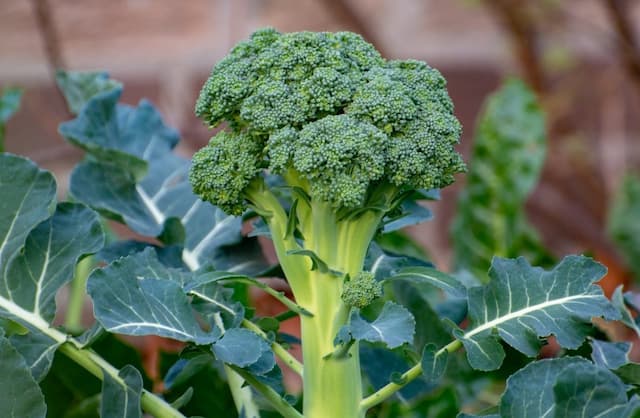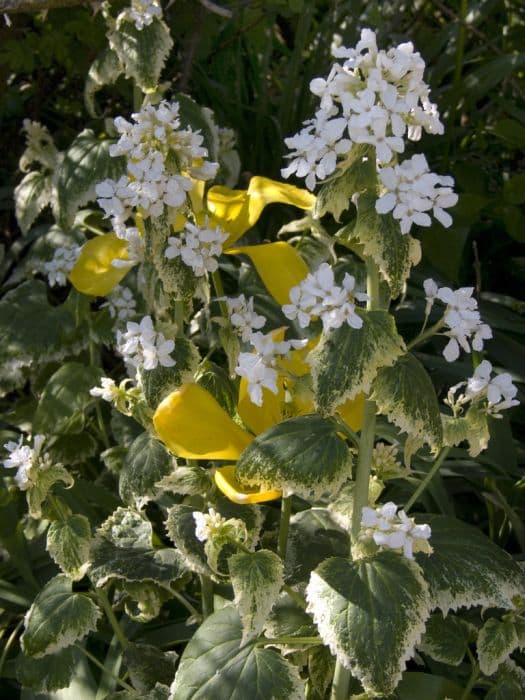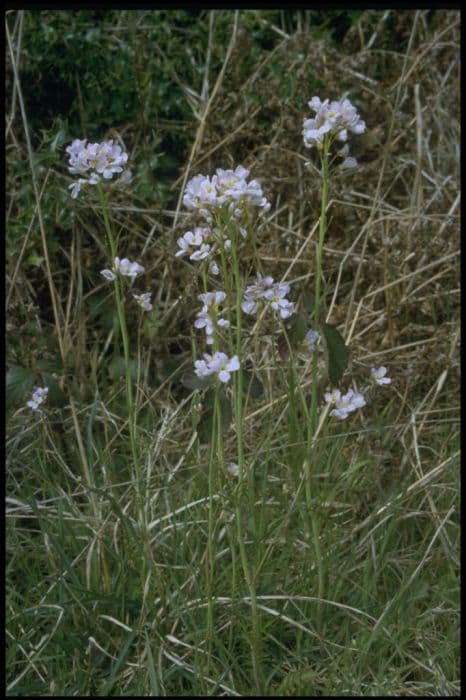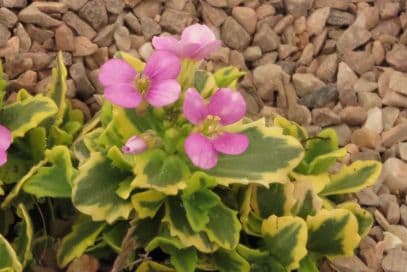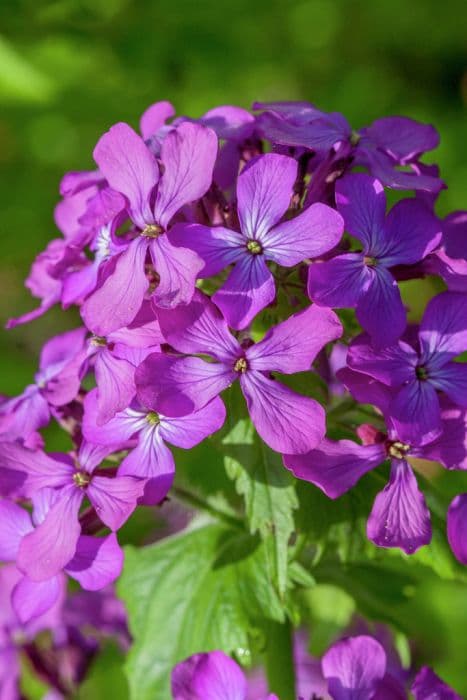Charlock Sinapis arvensis

ABOUT
The plant known as field mustard exhibits a distinct appearance characterized by its vibrant yellow flowers. Each flower typically has four petals arranged in a cross shape, which is a common feature among plants in its family. These bright yellow flowers are eye-catching and can add a splash of color to the surroundings. The leaves vary from the base of the stem to the top, with the lower leaves tending to possess a rougher texture, and sometimes have a lobed or toothed edge, providing a slightly irregular appearance. These lower leaves often appear more spread out around the base of the plant. The leaves higher on the stem usually stick closer to the stem and are generally narrower and smoother than the lower leaves. The plant's stem is erect and can branch out, creating a somewhat bushy look. The stems and leaves may sometimes have fine hairs covering them, but this can vary. The seedpods that develop after flowering are elongated, and their size can vary. These seedpods, containing the seeds, stand upright or slightly angled upward from the stem, distinguishing themselves from the foliage with their slender form. When the seeds ripen, the seedpods can burst open, dispersing the seeds from the parent plant. The entirety of the field mustard plant, with its combination of distinct yellow flowers, varying leaf shapes, and upright seedpods, presents a noticeable and characteristic presence in the areas where it grows.
About this plant
 Names
NamesFamily
Brassicaceae.
Synonyms
Wild Mustard, Charlock, Field Mustard, Corn Mustard, Charlock Mustard, Wild Turnip.
Common names
Brassica arvensis, Brassica kaber, Sinapis arvensis var. orientalis, Brassica sinapistrum, Brassica arvensis var. orientalis.
 Toxicity
ToxicityTo humans
Sinapis arvensis, commonly known as wild mustard, is not typically considered highly toxic to humans. However, ingesting it in large quantities may lead to digestive disturbances such as gastrointestinal irritation due to the plant's chemical compounds which include glucosinolates. Additionally, the seeds contain small amounts of erucic acid which can be toxic in high concentrations, potentially leading to heart or kidney problems. Despite this, toxicity incidents in humans are rare and often limited to mild symptoms.
To pets
Wild mustard may also pose a risk of toxicity to pets, including dogs, cats, and horses. If ingested in significant amounts, the glucosinolates found in the plant can cause gastrointestinal upset, such as vomiting and diarrhea. In some cases, there can be more severe symptoms like abdominal pain. It is not typically a plant of high toxicity to pets, and serious cases are infrequent, but pet owners should discourage their animals from consuming wild mustard and consult a veterinarian if large amounts have been ingested.
 Characteristics
CharacteristicsLife cycle
Annuals
Foliage type
Deciduous
Color of leaves
Green
Flower color
Yellow
Height
1-3 feet (30-90 cm)
Spread
1 foot (30 cm)
Plant type
Herb
Hardiness zones
7
Native area
Europe
Benefits
 General Benefits
General Benefits- Soil improvement: Sinapis arvensis, commonly known as wild mustard, can act as a green manure crop that enriches soil with organic matter and valuable nutrients when plowed back into the earth.
- Weed suppression: The rapid growth and dense foliage of wild mustard can outcompete weeds, thereby helping to control their spread in cultivated fields.
- Pest management: Wild mustard has been observed to attract pests away from more valuable crops, functioning as a trap crop.
- Support for beneficial insects: It provides a habitat and food source for beneficial insects like pollinators and predatory insects that can aid in the biological control of pests.
- Food for wildlife: The seeds and leaves of wild mustard can serve as a food source for wildlife such as birds and insects.
- Erosion control: When established, the root system of Sinapis arvensis can help stabilize soil and prevent erosion.
- Cover cropping: As a cover crop, it can protect the soil from extreme weather conditions, maintaining soil structure and health.
- Biodiversity enhancement: Adding wild mustard to an agricultural landscape can increase plant diversity, which may in turn support a wider range of animals and other organisms.
- Rotational cropping benefits: Wild mustard can be used in crop rotations to break cycles of diseases and pests that affect specific crops.
 Medical Properties
Medical Properties- Anti-inflammatory: Sinapis arvensis has been used to reduce inflammation in traditional medicine.
- Antimicrobial: The plant possesses properties that may inhibit the growth of certain bacteria and fungi.
- Respiratory health: It is used in folk medicine for the symptomatic treatment of respiratory conditions.
- Diuretic effect: Traditional uses include promoting the production of urine to relieve fluid retention.
- Antioxidant: The seeds contain compounds that are believed to have antioxidant effects.
- Topical use for skin: Historically, it has been applied externally for skin irritations and joint pain.
 Air-purifying Qualities
Air-purifying QualitiesThis plant is not specifically known for air purifying qualities.
 Other Uses
Other Uses- Sinapis arvensis, commonly known as wild mustard, can be used as a cover crop to suppress weeds and prevent soil erosion due to its rapid growth and dense foliage.
- The plant can serve as a trap crop, attracting pests away from more valuable crops in the vicinity.
- Wild mustard has potential as a green manure, being ploughed back into the soil to improve soil fertility through the addition of organic matter.
- It can act as an indicator species, since its presence often indicates certain soil conditions, such as compacted soils.
- The seeds of wild mustard can be used as a spice or condiment, although less commonly than other mustard species; they add a pungent flavor to some dishes.
- The flowering plant can be a source of nectar and pollen for beneficial insects, including bees and butterflies, thus playing a role in supporting local ecosystems.
- Wild mustard might be utilized in bioremediation efforts, as certain plants have the ability to take up and sometimes stabilize heavy metals or other contaminants in the soil.
- The strong and fibrous stems and leaves of the plant can be used as a source of biomass for biofuel production.
- Its extensive root system can be used in phytoremediation to break up hardpans and improve soil structure over time as the roots decompose.
- When dried, the plant can be used as mulch for garden beds to retain moisture and provide a barrier against soil-borne diseases.
Interesting Facts
 Feng Shui
Feng ShuiWild mustard is not used in Feng Shui practice.
 Zodiac Sign Compitability
Zodiac Sign CompitabilityWild mustard is not used in astrology practice.
 Plant Symbolism
Plant Symbolism- Persistence: Sinapis arvensis, commonly known as wild mustard, is known for its ability to grow in adverse conditions, symbolizing resilience and determination.
- Invasiveness: Being an aggressive and competitive plant, wild mustard can represent the concept of invasiveness or unwelcome interference.
- Growth: The rapid growth of wild mustard can symbolize personal growth or the expansion of ideas.
- Protection: In some traditions, mustard is believed to ward off evil spirits, making wild mustard a symbol of protection.
 Water
WaterField mustard, commonly known as Sinapis arvensis, prefers to be watered deeply but infrequently to encourage strong root growth. During its growing season, watering once a week with approximately one gallon of water should be sufficient, but this can vary based on climate conditions and soil type. It's important to check the top inch of soil for dryness before watering again. Overwatering can lead to root rot, so ensure that the soil drains well and does not remain soggy. During prolonged dry spells or hot weather, you may need to water more frequently, but always allow the soil to dry slightly between waterings.
 Light
LightField mustard thrives in full sunlight, so the best spot for this plant is one where it can receive at least six hours of direct sunlight each day. It can tolerate partial shade, but too much shade can lead to weak growth and fewer flowers. Ensure that the chosen site is away from taller plants or structures that might create significant shade during the day.
 Temperature
TemperatureFor field mustard to thrive, the ideal temperature range is between 60°F and 70°F. It can tolerate a minimum temperature of around 40°F and a maximum temperature up to about 85°F. These plants do well in moderate climates and can even withstand light frost, but prolonged exposure to temperatures outside the stated range can be detrimental to its health.
 Pruning
PruningField mustard, or wild mustard, typically does not require extensive pruning. However, removing spent flowers and any damaged or diseased leaves can promote healthier growth and prevent the plant from self-seeding excessively. The best time for pruning is after the plant has flowered and the flowers have begun to fade, which is usually in late spring or early summer.
 Cleaning
CleaningAs needed
 Soil
SoilWild mustard (Sinapis arvensis) thrives in well-drained, loamy soil with a pH between 5.5 and 7.5. A balanced mix of sand, silt, and clay with organic matter like compost will promote healthy growth.
 Repotting
RepottingWild mustard, or Sinapis arvensis, being an annual weed, does not typically require repotting as it completes its lifecycle within one year and can self-seed prolifically.
 Humidity & Misting
Humidity & MistingWild mustard, commonly called Sinapis arvensis, prefers moderate humidity levels but is quite adaptable and can thrive in a range of humidity conditions found in natural outdoor environments.
 Suitable locations
Suitable locationsIndoor
Ensure full sun and well-drained soil for wild mustard indoors.
Outdoor
Plant wild mustard in full sun and till soil for better growth.
Hardiness zone
3-10 USDA.
 Life cycle
Life cycleThe life of Sinapis arvensis, commonly known as wild mustard, begins with the germination of its seeds in the soil when conditions are favorable, typically in the spring. Once sprouted, the seedling grows into a rosette of leaves close to the ground, absorbing sunlight and nutrients. The plant then develops a flowering stem, which produces bright yellow flowers that are self-compatible and can be pollinated by insects. After pollination, the flowers develop into elongated seed pods called siliques, which contain the seeds. When mature, the seed pods dry out and split open, dispersing the seeds into the surrounding environment. The plant completes its life cycle when it dies after seed dispersal, which can occur within a single growing season as wild mustard is typically an annual plant.
 Propogation
PropogationPropogation time
Spring
Propogation: Wild mustard, or Sinapis arvensis, is typically propagated through seeds. The best time for sowing wild mustard seeds is during early spring, when the risk of frost has passed, or in fall, where winters are mild. Seeds should be sown directly into the ground where the plants are intended to grow. They prefer well-drained soil and a full sun location. After preparing the soil to a fine tilth, scatter the seeds evenly and cover them lightly with soil, roughly 1/4 inch deep. Watering should be done gently to moisten the soil without causing the seeds to wash away. Germination typically occurs within 10 to 14 days, provided the soil temperature is around 45 to 85 degrees Fahrenheit (7 to 29 degrees Celsius). Thin out the seedlings to 6 to 8 inches (15 to 20 centimeters) apart once they have developed a couple of true leaves.
